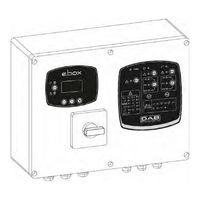DAB E.Box Plus D Manuales
Manuales y guías de usuario para DAB E.Box Plus D. Tenemos 2 DAB E.Box Plus D manuales disponible para descarga gratuita en PDF: Instrucciones De Instalación Y Mantenimiento
DAB E.Box Plus D Instrucciones De Instalación Y Mantenimiento (797 páginas)
Marca: DAB
|
Categoría: Paneles de Control
|
Tamaño: 12 MB
Tabla de contenido
-
Italiano
3-
Legenda
8 -
-
-
-
-
-
-
Menù49
-
-
-
Menù Utente51
-
-
-
Menù Monitor52
-
LA: Lingua52
-
-
-
English
64-
Key
69 -
Warnings
69 -
1 General
70 -
-
-
-
-
System Operation100
-
-
Expansion Vessel102
-
System Operation107
-
Pressure Sensor107
-
-
-
-
Status Line110
-
Menus110
-
-
User Menu112
-
Monitor Menu113
-
LA: Language113
-
Setpoint Menu113
-
Pressure Sensor)113
-
Installer Menu114
-
Boosting)115
-
AL: Anti-Leakage115
-
-
-
-
-
-
Dip-Switch Alarm119
-
Error Alarm119
-
Input Voltage119
-
Voltage Error120
-
Internal Error120
-
-
RI: RI Alarms122
-
NI: ni Alarms122
-
W1: Trimmer SP123
-
W2: Trimmer DP123
-
W3: Trimmer Imax123
-
PK: Key Error124
-
-
Français
125-
Avertissements
130 -
Légende
130 -
Responsabilités
130 -
1 Généralités
131 -
2 Installation
132 -
3 Panneau Avant
137 -
-
Vase D'expansion140
-
-
Pressostats146
-
-
-
-
-
-
Vase D'expansion163
-
-
-
-
Pressostats168
-
-
-
-
Barre D'état171
-
Menu171
-
Accès aux Menus171
-
-
Menu Utilisateur173
-
Menu Écran174
-
LA : Langue174
-
De Profondeur)175
-
AL : Anti-Fuite176
-
-
-
-
-
Alarme Erreur180
-
Tension D'entrée180
-
Erreur Interne181
-
-
RI : Alarmes RI183
-
NI : Alarmes ni183
-
W1 : Trimmer SP184
-
W2 : Trimmer DP184
-
-
Deutsch
186-
Hinweise
191 -
Legende
191 -
Haftung
191 -
1 Allgemeines
192 -
2 Installation
193 -
3 Frontpaneel
198 -
-
Ausdehnungsgefäß201
-
-
6 Füllfunktion
208-
Steuereingänge208
-
-
Steuereingänge216
-
-
Ausdehnungsgefäß224
-
-
-
-
Statuszeile232
-
Menü232
-
-
Benutzer-Menü234
-
Monitor-Menü235
-
LA: Sprache235
-
Sollwert-Menü235
-
Mit Drucksensor)235
-
MS: Maßsystem236
-
Druckerhöhung)237
-
ET: Wechselmodus237
-
-
-
-
-
-
Pumpe Abgehängt240
-
Alarm DIP-Switch241
-
Fehler-Alarm241
-
Eingangsspannung242
-
Spannungsfehler242
-
Interner Fehler242
-
-
RI: Alarme RI244
-
NI: Alarme ni244
-
W1: Trimmer SP245
-
W2: Trimmer DP245
-
W3: Trimmer Imax246
-
Publicidad
DAB E.Box Plus D Instrucciones De Instalación Y Mantenimiento (63 páginas)
Marca: DAB
|
Categoría: Paneles de Control
|
Tamaño: 1 MB
Tabla de contenido
-
-
-
-
Menú Usuario50
Publicidad

